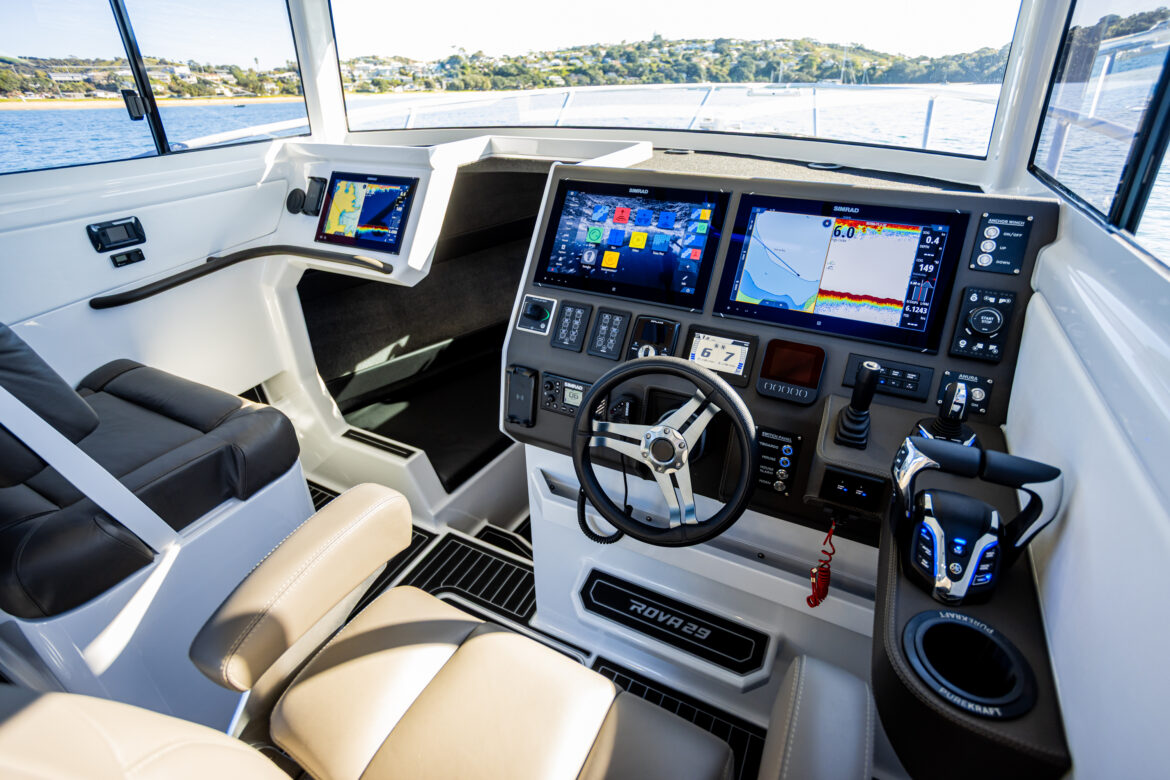
When the folks at Pacific PowerBoat magazine asked me to write an article about mid-range MFDs, I thought to myself: “What do I really know about these, even though I’ve been boating most of my life and that I’m familiar with them?” Indeed, when it comes down to it, what is a boat MFD? And, for the purpose of this article, what qualifies as a mid-range MFD?
Well, for a start, simply stated, a marine MFD refers to a Multi-Function Display used on boats. I knew that they offered the ability to find fish, chart the sea bottom, find a safe route to an overnight anchorage, had the ability to link in radar and numerous other functions and that they are now typically integrated into the boat’s helm station as a single flat screen unit. But beyond that, what did I really know about the ‘state of the art’ units, currently available on today’s market?
The more I researched and the more I spoke to the people who make and sell these marvellous instruments, the more I realised that I really knew bugger all and that, if I was going to write an article about MFDs that the average boatie could understand and relate to, I had to break it all down into everyday language.
So, let’s start by defining an MFD as an electronic display unit that integrates and shows data from various marine systems. Think of it as the central “dashboard” of a boat, combining information from different sensors and devices onto one screen. In other words, much like your smartphone, tablet, vehicle touch screen or even your smart TV.
Advanced warning! There is a lot of technical jargon involved when discussing MFDs. In fact, as I delved deeper into my research, I thought at times that I was reading Greek or Latin, rather than English and that in describing MFDs there are more acronyms than you can shake a stick at. For example, if you know all the terminology, the following sentence will make perfect sense to you. But if you don’t, it is likely (unless you are techno type person) that your eyes will start glazing over halfway through reading it.
“Modern day MFDs comprise a NMEA 2000 networking protocol which is a CAN Bus technology utilising standardised “trunk” or backbone cables and branch lines called “drops” or “stubs” and, when connected to the network, some displays, in addition to functions such as GPS and Fishfinders, may show ‘virtual engine gauges’ onscreen.”

See what I mean? So, to help you out with the technical stuff, there is a Glossary of Common Terms at the end of this article.
However, cutting through the techno stuff, marine MFDs typically display:
• GPS and Chartplotter: Navigation maps and vessel position.
• Sonar/Fishfinder: Underwater views showing depth, fish, and structures.
• Radar: Helps detect other boats, land, or obstacles.
• AIS (Automatic Identification System): Shows information about nearby vessels.
• Engine Data: RPM, fuel levels, temperatures, etc.
• Autopilot Controls: Some integrated into your MFD program or perhaps linked to your outboard controls.
• Weather Data: Overlay weather maps by simply connecting to your apps for example.
• Cameras (if installed): FLIR (Forward Looking InfraRed) for use at night or compact digital units, bow mounted to monitor your anchor deployment for example.
• C-Zone: Replaces switch and fuse panels with state-ofthe-art, robust interfaces and light NMEA 2000 network cable.
• Battery monitoring
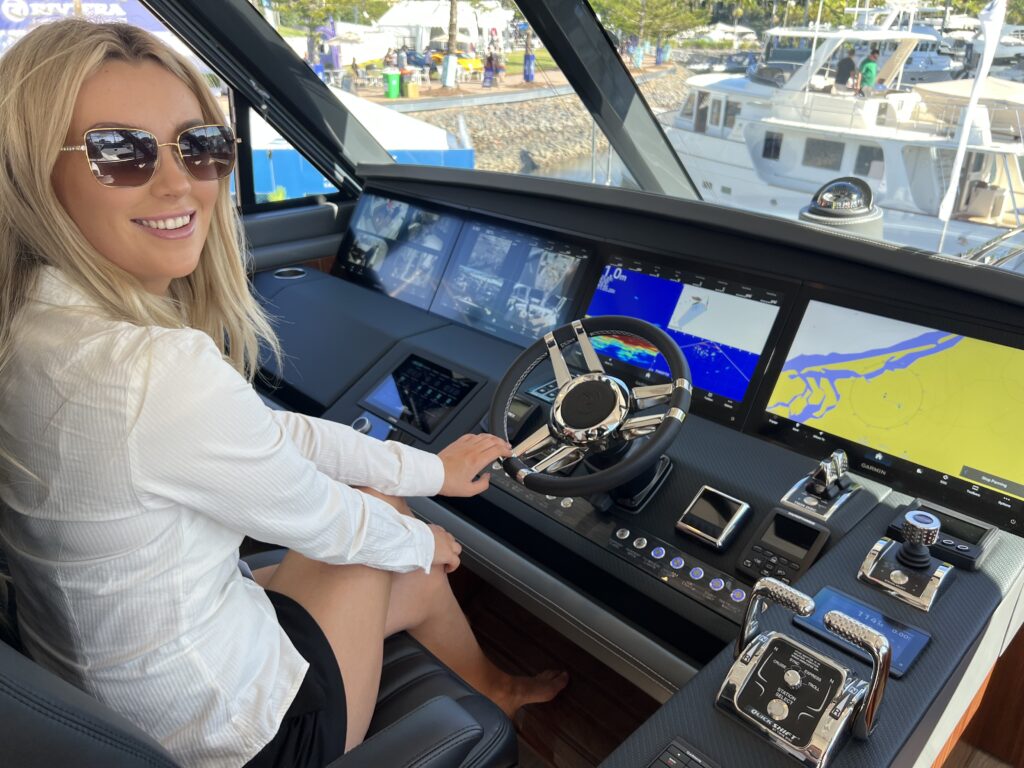
MFDs are now considered essential for modern boating – especially on recreational fishing boats, yachts, pleasure and commercial vessels – because they consolidate multiple pieces of equipment into one userfriendly interface. As there is a plethora of models on today’s market for every type of vessel, I’m restricting this article to those mid-range units, from each of the above brands, that may be most suitable for boats from about 6 metres to about 12 metres, but which are, for this article, eminently suitable for trailer and amphibious boats.
An interesting side note at this point is that just over a decade ago, MFDs that are today routinely fitted to your average 6 or 7 metre trailer boat might have only been found on large commercial fishing boats or luxury end, large launches. Currently, mid-range MFDs (typically 9” or 12” screen units) are now commonplace on most recreational boats, no matter what their size. What blows me away is how popular and mainstream they’ve become on amphibious and trailer boats, with most being flush mounted into the helm station, rather than ‘bolted’ onto the dash as an almost after-market product.
But let’s get into what each of the brands offer and hopefully make it a bit easier for you to decide which brand and model may be most suitable for you. Having said that, you will find that any given boat builder often has their own ideas as to which they think is the best brand and/or model to install on their boats. So, unless you are actively involved in the build process, you may not have a choice if you are buying a boat already set up at a dealership. And that is not necessarily a bad thing, as all the brands we are going to talk about have been around for years and all have reputable credentials. In the end, it will often come down to the features you want and your budget.
WHAT DO THEY OFFER?
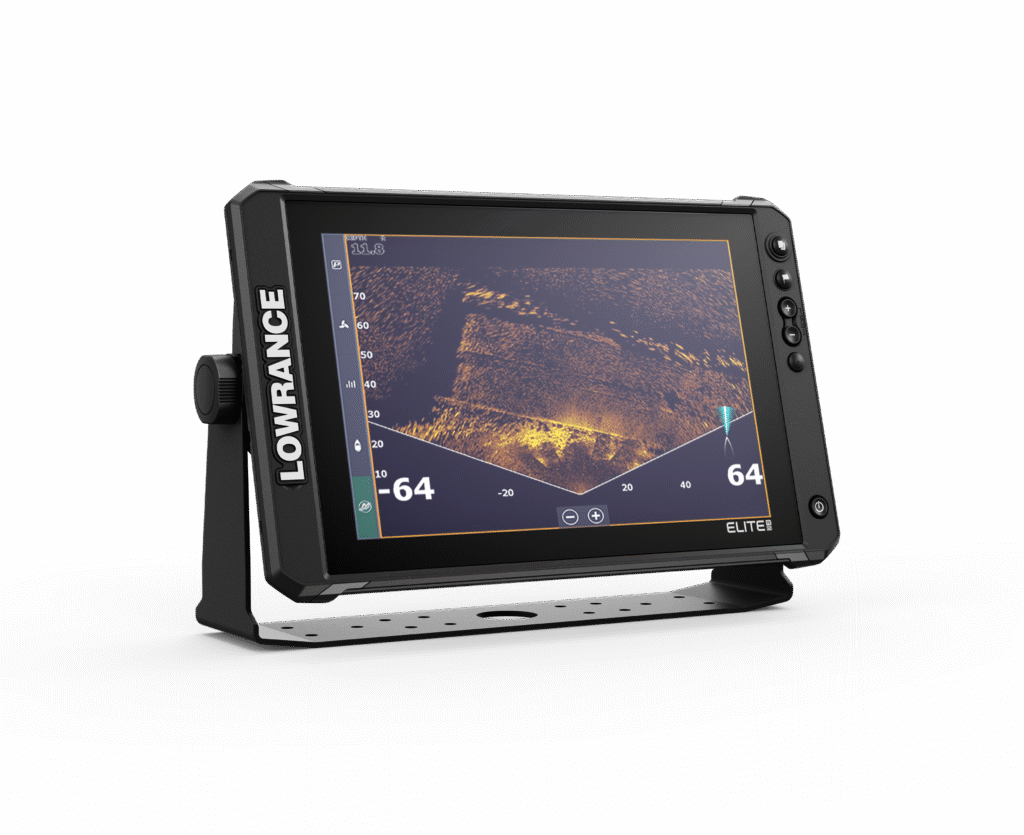
LOWRANCE:
Lowrance MFDs are designed for anglers and offer a combination of features at a moderate price. Key models in this category include the EliteFS® series and the HDS®Pro series. These MFDs feature high-resolution displays and support CHIRP sonar, DownScan and SideScan imaging (with Active Imaging), and are compatible with live sonar systems such as ActiveTarget, making them ideal for trailer boat use.
EliteFS®:
The Elite Fishing System (FS) combines the power of Lowrance’s proven and newest fishfinding tools with a more affordable display that’s easier to use and install. From ActiveTarget™ live sonar and extreme high-resolution Active Imaging™ with Lowrance CHIRP sonar, SideScan and DownScan Imaging™ , to preloaded C-MAP® Enhanced Embedded Fishing Maps, Elite FS gives you all the tools you need to find and catch more fish.
•ActiveTarget™ 2 Live Sonar ready
• Active Imaging 3-in-1 ready
• Active Imaging HD 3-in-1 ready with a S3100 Sonar Module
• FishReveal™
• Preloaded C-MAP Enhanced Embedded, plus mapping options including C-MAP, Navionics® and more
• C-MAP® Easy Routing, Navionics® Autorouting™ capability
• C-MAP Genesis Live onscreen mapping
• High-resolution multi-touch touchscreen
• Integrated wireless, NMEA 2000® and Ethernet connectivity
• Full touchscreen control of Recon™ and Ghost® Trolling Motor, as well as Power Pole® Anchors
HDS®Pro:
See more and catch more with the new HDS PRO fishfinder/ chartplotter. Watch fish react to your lure live with new, highresolution ActiveTarget® 2 Live Sonar, and find fish and holding structure with new, Ultra High-Definition Active Imaging™ HD. Quickly find fishing areas with the latest and most detailed C-MAP® charts and get full fishing system networking with expanded boat control from bow to stern.
• SolarMAX™ HD Touchscreen viewable at extreme angles and through polarised lenses
• New! High-Definition up to 1.2MHz Active Imaging™ HD ready (Lowrance CHIRP/SideScan/DownScan Imaging™)
• New! High-resolution ActiveTarget® 2 Live Sonar ready
• FishReveal™ with new SideScan view, as well as Downscan
• Available in 9, 10, 12 and 16-inch display size
• Preloaded C-MAP® Enhanced charts for New Zealand and Australia
• Real-time mapping available with C-MAP® Genesis Live.
• Support for new ActiveTarget® Scout and Ghost® Trolling Motor 360 chart overlay views
• Large programmable keys for 10, 12 and 16-inch sizes
• Touchscreen control of Power-Pole® anchors, Ghost® Trolling Motor, Autopilot and Lowrance Outboard Pilot
• NMEA 2000®, Wireless and Bluetooth®, connectivity – plus smartphone notifications
• Wide range of optional chart upgrades including C-MAP® REVEAL, Navionics®, Florida Marine Tracks and more.
For the New Zealand market, the HDS Live comes with an Embedded C-MAP chart, upgradeable to a C-MAP Reveal NZ chart, which features a breathtaking Shaded Relief Layer of the bottom. This makes it super easy to see reefs, drop-offs, and new fishing spots.
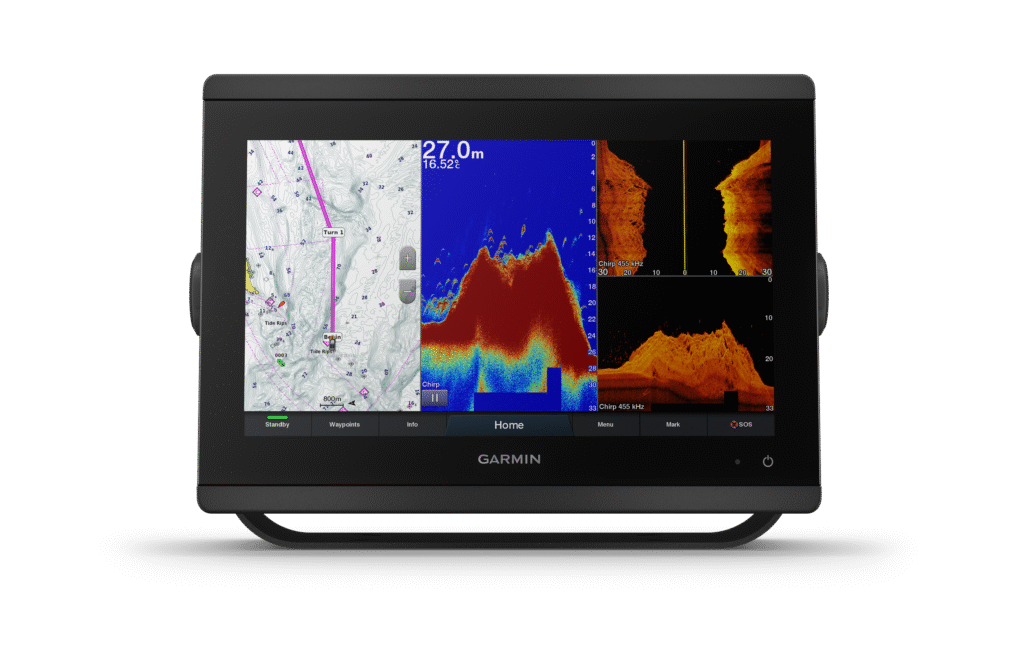
GARMIN:
Garmin’s mid-range MFDs typically include the ECHOMAP UHD2 Series and the GPDMAP 8400 series. These MFDs offer a range of sizes and features, including chartplotting, sonar, radar integration and more, thus catering to a wide range of various boat types and user needs.
Garmin ECHOMAP UHD2 Series: A popular line of Chartplotter/Fishfinder combos designed for various marine activities. Known for their clear sonar and built-in charts, they are available in mid-range sizes 5” to 9”, as well as larger 10” – 16” models, all featuring Ultra High-Definition scanning sonar (ClearVü and SideVü). The Garmin GPSMAP 8400 series is a separate, higher-end offering of MFDs with larger screens (10”, 12” or 16”) and premium features combined with robust network integration capabilities.
Garmin GPSMAP 8400 Series: This series delivers a premium user experience, featuring high-resolution displays and advanced processing capabilities for seamless chart plotting and enhanced situational awareness. It comprises models such as the 8412, 8416, and 8422, each offering different screen sizes to accommodate a range of boat dashboard requirements. These MFDs deliver high performance and versatile features for various size boats and are available in multiple screen sizes to suit different helms.
They feature built-in CHIRP (Compressed High-Intensity Radiated Pulse) sonar and support ClearVü and SideVü scanning for detailed underwater imaging. Seamless integration and robust network connectivity with Garmin radar, autopilot, and onboard systems is included ensuring rapid data sharing with compatible Garmin devices.
Other Relevant Information: It is important to note Garmin’s recent progression into Live Sonar with their Panoptix range as well as seamless integration with the Garmin Force & Kraken trolling motors on their MFDs. Having Navionics Relief shading preloaded on the Vision chart cards as well as featuring their famous ‘any sonar anytime’. Which simply means that you can run as many sonars as you like at one time on the 8400 and 9000 series. Round this all off with Quatix watch integration which allows you to run your autopilot or trolling motor from your boat. The new GPSMAP 7×3 (7” screen) series represents a more compact alternative that maintains an effective balance between features and performance.
When choosing a mid-range Garmin MFD, it is important to consider factors such as screen size, required functionalities (including sonar, radar, and autopilot integration), as well as the dimensions and type of your vessel.
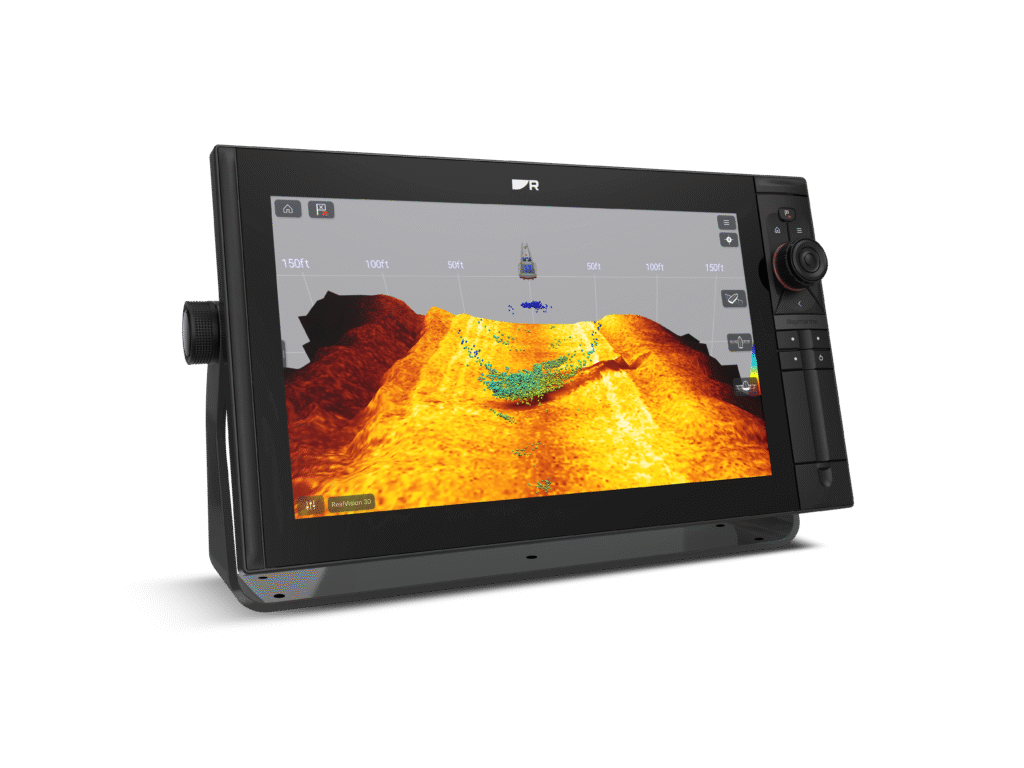
RAYMARINE:
Raymarine’s mid-range multifunction displays, notably the Axiom and Axiom+ series, deliver comprehensive features for navigation, fishfinding, and seamless integration with other onboard systems. The Axiom series is distinguished by its all-glass touchscreen interfaces, robust processing capabilities, and scalability. The Axiom+ models are specifically engineered to provide increased speed, superior screen brightness, enhanced image clarity, and durable construction for demanding marine environments.
Key Features of Raymarine Mid-Range Axiom and Axiom+ Series MFDs: The Axiom is a well-known series featuring all-glass touchscreens and robust performance, while the Axiom+ offers improved brightness, sharpness, and durability. Both serve as key products in Raymarine’s mid-range MFD lineup, with a variety of sizes and features to suit different vessels and needs.
• Touchscreen Interface: All-glass touchscreens provide responsive, intuitive control, even when wet.
• Powerful Processing: The Axiom+ series features a quadcore processor that delivers high-speed performance, seamless chart rendering, and supports augmented reality navigation.
• Expandability: Axiom MFDs are compatible with various Raymarine accessories, such as radar, sonar, and thermal cameras, enabling users to configure their systems according to specific requirements.
• Connectivity: Wi-Fi and Bluetooth functionality allows connection with Raymarine applications for tablets and smartphones, as well as integration with other onboard devices.
• Display Technology: Axiom+ models feature IPS display technology, offering wide viewing angles and defined images; they include Raymarine’s HydroTough Display, which is nano-coated and impact-resistant to minimise water and smudge accumulation.
• Sonar Capabilities: Certain Axiom models, including the Axiom Pro RVX, incorporate CHIRP sonar technology designed for use in both deep and shallow water, with multiple sonar band options available.
• GPS and GNSS: Axiom MFDs generally contain a high-sensitivity, 10-hertz GNSS (Global Navigation Satellite System) receiver that supports GPS, GLONASS (Russia’s equivalent to USA GPS), Galileo (European GPS), and BeiDou (Chinese GPS) for precise positioning.
In summary, Raymarine’s mid-range MFDs, including the Axiom and Axiom+ series, provide touchscreen controls, performance features, and expandability, making them applicable for various boating uses.
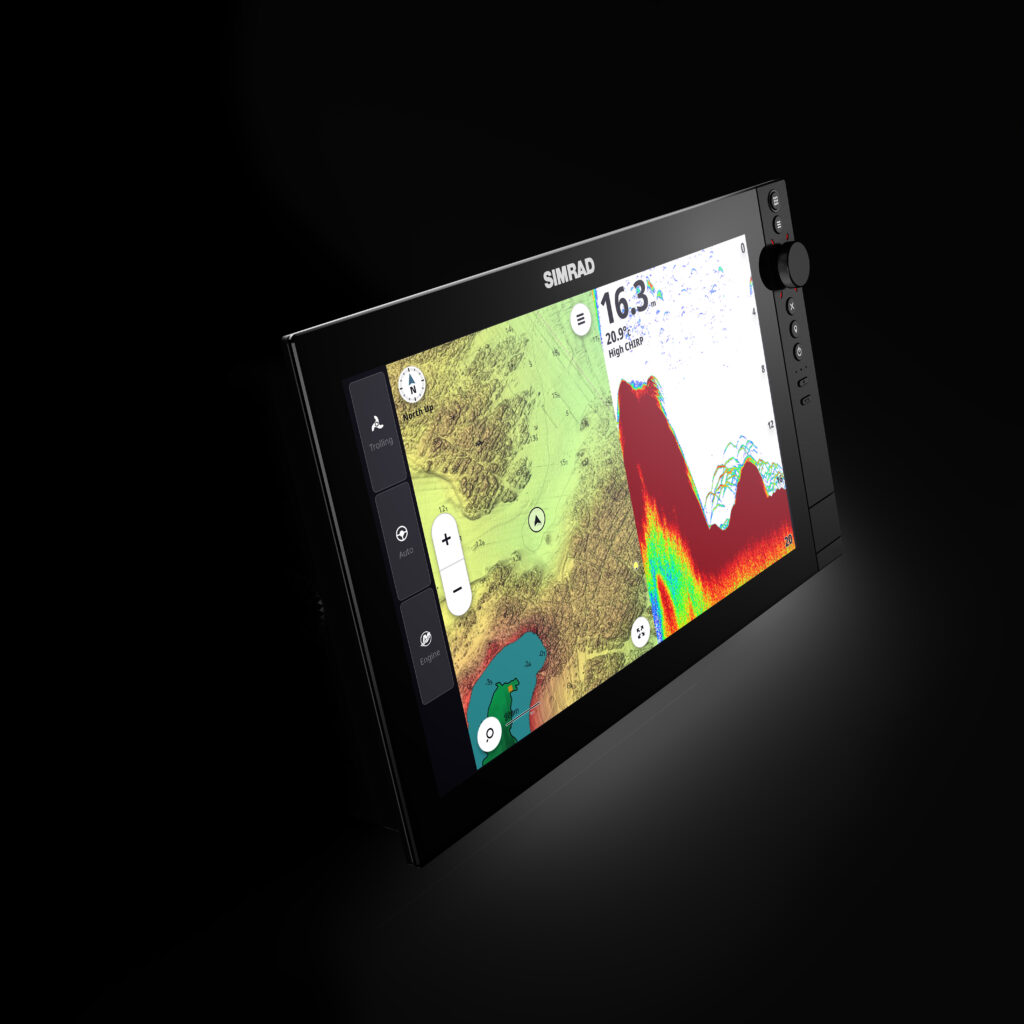
SIMRAD:
Simrad’s MFDs, including the NSX and NSS4 series (larger boats), provide a comprehensive blend of performance and features tailored for both anglers and boaters. The NSX series, representing the latest addition to the lineup, offers an intuitive touch-screen interface, C-MAP navigation, and seamless integration with the Simrad app for enhanced smartphone connectivity, making it ideal for the trailer boat market.
Simrad® NSX Series:
The future is here with NSX®. Experience the simplicity of their latest operating system, introducing a redesigned charting experience, their fastest-ever auto-routing, and seamless integration for total control of your boat. NSX comes fully equipped with integrations for Sonar, Radar, and Autopilot Systems. Crafted specifically for fluidity and ease of use, with NSX you’ll spend less time on the screen, and more time on your next adventure. The NSX 3012 is aimed more at families and those who may be new to boating and are ideally suited to trailer boats when only a single transducer is required.
• Sonar sharing
• Full Mercury Integration, inc. SmartCraft® Connect and VesselView®
• SolarMAX™ IPS HD touchscreen with extreme viewing angles
• Compatible with Active Imaging™, featuring CHIRP, SideScan, and DownScan Imaging™
• Compatible with C-MAP® DISCOVER™ X AND REVEAL™ X charts
• See near and far with full HALO® radar support
• Easy autopilot integration
• Full C-Zone monitoring /control with excellent third-party integration. E.g. CZone®, OmniSense, Dometic, Lumishore, etc.
• Simrad® App integration*
• Wireless connectivity, plus full Ethernet, USB, and NMEA 2000® networking capability
• IP Camera video support
• New Setup Wizard to get you up and running quickly
Simrad® NSS®4 Series:
Redesigned inside and out, NSS® 4 is sleeker, faster and smarter. The touchscreen, rotary dial, and keypad all work in harmony for superior control. Advanced fishfinding capabilities such as dual channel 1kW CHIRP sonar, Active Imaging™ HD support, and enhanced customisation complete the package for this premium, allin-one sports chartplotter and fishfinder.
• Trio of hybrid controls: touch screen, rotary knob, and keypad
• Premium glass-to-edge design
• Lightning-fast Qualcomm® 8-core processor
• Redesigned operating system
• Built-in dual channel 1kW CHIRP echosounder
• Support for Active Imaging™ & Active Imaging™ HD
• Support for C-MAP® X-gen charts and others
• Simrad® RECON™, Rhodan® and Motorguide® Trolling Motor Compatible
• Compatible with Simrad suite: S3100 & S5100 sonar modules, radar, and more…
• Support for Mercury®, CZone®, SiriusXM®, etc.
Key Features and Benefits:
• Intuitive Touchscreen Controls: Simrad MFDs are equipped with touchscreen technology, allowing operation through interfaces similar to those used in smartphones and tablets.
• Customisable Displays: The displays can be adjusted to present selected information according to user preferences.
• Integration: MFDs support integration with other onboard systems such as autopilots, radar, and engine monitoring.
• Upgradable: These devices may be used to modernise boats by replacing older dials and displays with integrated functionality.
• Ease of Use: Simrad MFDs include features such as quick access to settings and one-touch functions for straightforward operation.
• Fish Finding: Sensitive at any depth and capable of detecting single fish below 1000 meters.
• Commercial Operation: Simrad offers specifically targeted units for this market.
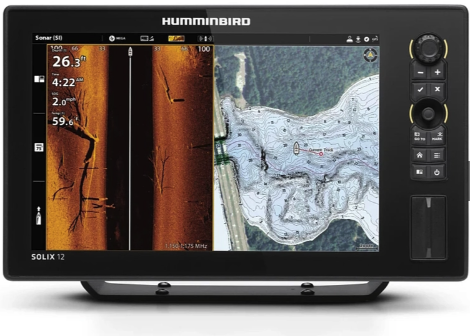
HUMMINBIRD:
Humminbird’s mid-range MFDs comprise the HELIX 7–10, 12, plus the 15-inch SOLIX and APEX series, offering a wide range of screen sizes and advanced functions. Key features include CHIRP sonar, MEGA Side and Down Imaging for enhanced detail, integrated GPS, and Ethernet networking capabilities.
HELIX Series:
HELIX 7, 8, 9, 10, 12, and 15 G4N models: These units come in various screen sizes and include features such as CHIRP sonar, MEGA Imaging, GPS, and Ethernet networking. The “N” suffix specifies network compatibility, enabling data sharing across multiple devices.
• HELIX 7 CHIRP GPS G4N: Provides a combination of standard features and medium-sized display.
• HELIX 9, 10, 12 CHIRP GPS G4N: Features larger screens and additional functions, including MEGA Imaging.
• HELIX 15 CHIRP GPS G4N: The largest screen size available in the HELIX line, designed for an expanded view of the water.
SOLIX Series:
• SOLIX G2 and G3 Models: Come equipped with large, high-resolution displays and incorporate advanced sonar technologies such as MEGA Imaging and MEGA 360.
• SOLIX 12 CHIRP MEGA SI+ G3: This model is frequently selected by anglers seeking robust side imaging and down imaging performance.
Key Features to Consider:
• CHIRP Sonar: Delivers detailed images of fish and underwater structures.
• MEGA Imaging: Provides high-resolution Down Imaging and Side Imaging for comprehensive underwater views.
• GPS: Used for navigation and waypoint management.
• Ethernet Networking: Enables data sharing between multiple units and compatible devices.
• Screen Size: Select a size suitable for your boat that ensures clear visibility of information.
• Transducer Compatibility: Confirm that the transducer is compatible with the chosen MFD and desired sonar functions.
Summary: When choosing a mid-range Humminbird MFD, it is advisable to evaluate your budget, the dimensions of your vessel, and the features that are most relevant to your specific fishing requirements.
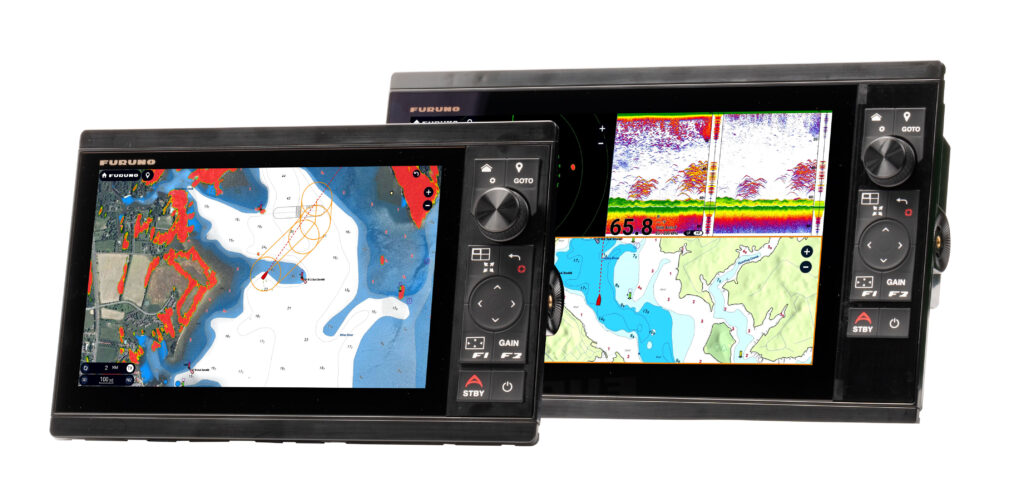
FURUNO:
Furuno’s mid-range Multi-Function Displays, the TZtouchXL series, are designed to accommodate a wide spectrum of marine needs, spanning both recreational and commercial applications. These MFDs are equipped with advanced processors, high-resolution screens, and integrated CHIRPenabled fish finding technology.
Key Features of Furuno Mid-Range MFDs:
• DISPLAYS: The TZtouchXL series offers 10″ and 13″ hybrid control models, as well as 16″, 22″, and 24″ all-glass display models and Black Box variant.
• PROCESSING POWER: TZtouchXL models are equipped with a hexacore processor.
• FISH FINDER: Most models feature TruEcho CHIRP and conventional Continuous Wave fish finders, with all units supporting network connectable DFF3-UHD (Ultra High Definition) Hi Power CHIRP Module for greater power and clarity.
• RADAR: Select models offer Furuno’s UHD Digital Radar, delivering clear visuals and improved detection at varying ranges. Additionally featuring Risk Visualizer which continuously assess potential hazards and risks, providing instantaneous visual representation to the mariner.
• NETWORKING: These MFDs connect with sensors such as radar and autopilots and integrate with TimeZero for cloud data backup and sync, while offering ‘at home planning’ with waypoint and route transfer via the free TZ iBoat app.
• CHIRP SIDE-SCAN: Available on certain units, Furuno’s CHIRP Side-Scan provides extensive side-scanning to locate fish and underwater structures.
• TIMEZERO MAPS with BATHYVISION TECHNOLOGY: “offthe-charts” bathymetric data, offering 8 cm resolution between contours, custom depth shading, wide chart areas and satellite photo-imagery. Dynamic Mooring utilises TZ-MAPS and TZWeather to allow boaters to select safe anchorages by integrating real-time data, giving colour code mooring status, GREEN for protected, ORANGE for partially protected and RED for exposed.
• TIMEZERO WEATHER: Free meteorological weather forecast service offering wind direction and speed, wind gusts, wave height & direction, air temp and air pressure, currents, rain, plus Oceanographic data such as sea surface temperature, sea surface height and chlorophyll concentration, offering unparalleled information for sport and game fishers, plus peace-of-mind for cruisers.
• BOTTOM DISCRIMINATION: Facilitates identification of seabed compositions, including rock, gravel, sand, and mud, enhancing both fishing operations and navigational accuracy.
• ACCU-FISH: Analyses echo returns to provide reliable estimates of fish size.
Furuno offers the best of both worlds with a full multitouch display plus a built-in keyboard featuring a Rotokey cursor pad and dedicated buttons. In short, its mid-range MFDs deliver robust performance, advanced features, and intuitive interfaces, making them ideal for a wide range of recreational and commercial marine applications.
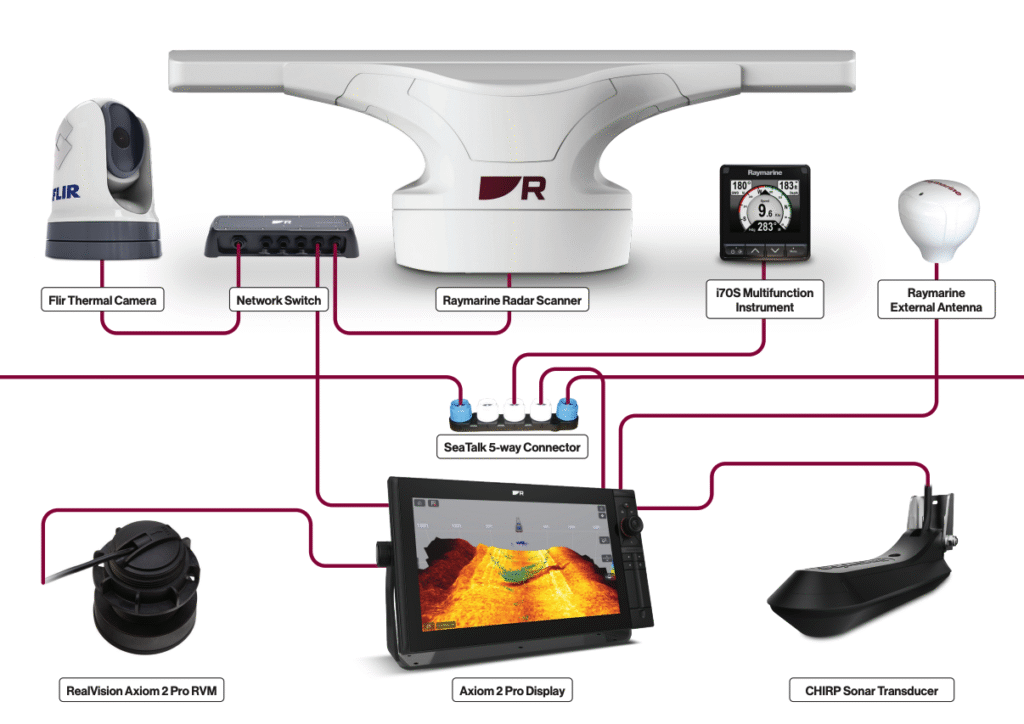
It is important to recognise that as multifunction displays (MFDs) have advanced, they are now predominantly touchscreen units, similar to the infotainment screens seen in modern vehicle dashboards. However, boats present a distinct set of environmental challenges compared to vehicles, as they are frequently exposed to moisture and harsh movement, which can complicate menu navigation or screen adjustments while underway. For this reason, you may want to consider touchscreen and hybrid multifunction displays, as these systems offer both intuitive touchscreen functionality and physical controls to enhance usability in demanding maritime conditions. Hybrid MFDs are particularly appreciated for their adaptability, allowing for interaction via touch as well as with rotary knobs and dedicated buttons. This dual-mode operation ensures reliable performance even in adverse conditions like rough seas, where touchscreen capabilities may be diminished.
Conclusion: There are numerous options available, and the best mid-range MFD for any given user depends on their specific requirements. Some individuals may prefer a model with basic fishfinding and chart plotting capabilities, while others might seek units with a wider range of features. The selection could also vary within the same brand, depending on desired functionalities. The purpose of this article is to assist readers in identifying what they need at a price point that fits their budget.
GLOSSARY OF TERMS:
NMEA 2000: Is a marine electronics communication standard designed for interoperability among devices on a boat. It is based on the Controller Area Network (CAN) bus, similar to those used in automotive applications, but adapted for marine use. The standard allows sensors and displays from different manufacturers to exchange data with one another.
CAN Bus Networks: A marine CAN bus network is a decentralised digital system that connects devices like engines, sensors, and control units on a boat. “CAN” stands for Controller Area Network, originally designed for automotive use and now common in marine electronics.
Transducers: A boat transducer is a crucial component of sonar systems, such as fishfinders and depth sounders. It converts electrical signals into sound waves sent into the water and detects the returning echoes to reveal what’s below, acting as both a speaker and microphone. These can be remotely stern-mounted (typically in trailer boats) or through-hull-mounted (typically in larger power boats).
Ethernet-based Networks: Connects devices within a Local Area Network (LAN) using physical cables such as twisted-pair copper or fibre optic, managed by switches and hubs. Unlike Wi-Fi, Ethernet provides more stable and typically faster connections through wired links.
CHIRP: On a boat, Compressed High-Intensity Radiated Pulse (CHIRP), originally developed by Simrad, is a type of sonar technology used in fish finders and sounders. CHIRP sonar provides more detailed images of underwater structures and fish than traditional sonar. While traditional sonar emits a single frequency pulse, CHIRP sends out a continuous sweep of multiple frequencies within each pulse, resulting in increased energy transmitted into the water and a more accurate return signal.
IPS (In-Plane Switching): An LCD technology found in monitors, IPS provides superior colour accuracy, wider viewing angles, and better image quality than TN (Twisted Nematic) and VA (Vertical Alignment), the two other main types of LCD panels.
C-MAP: A provider of electronic nautical charts and navigation data for boaters, offering detailed maps for lakes, coasts, and oceans. Its features include navigation info, fishing and diving spots, tides and currents, marina plans, and high-resolution bathymetric charts.


